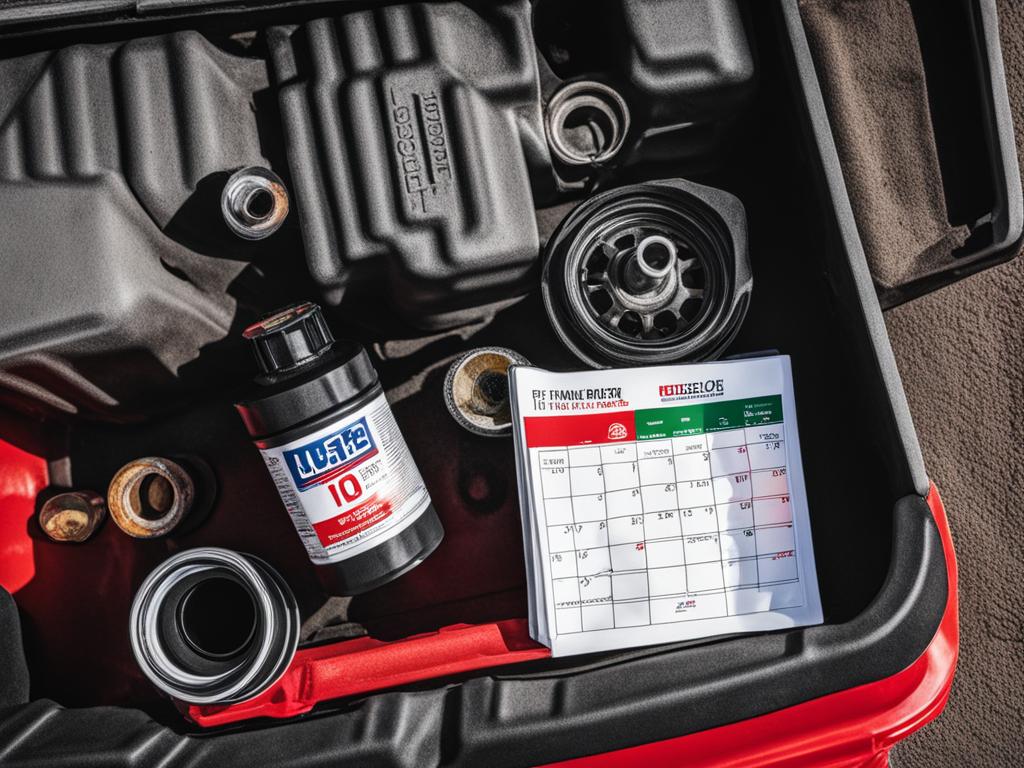Ford F150 Oil Change Guide – Quick & Easy Tips
Changing the oil in your Ford F150 is a crucial maintenance task that helps keep your vehicle running smoothly and efficiently. Whether you’re a seasoned DIYer or a beginner, this guide will provide you with quick and easy tips to successfully change the oil in your F150 at home. By following these steps, you can save time and money, while ensuring the longevity and performance of your F150.
Key Takeaways
- Regularly changing the oil in your Ford F150 is essential for maintaining its performance and longevity.
- It is recommended to change the oil every 3,000 to 5,000 miles or every six months, depending on driving conditions and oil type.
- Gather all the necessary tools and materials before starting the oil change process.
- Follow a step-by-step guide for changing the oil, including draining the old oil, replacing the filter, and adding new oil.
- Choosing the right oil for your F150 is crucial. Refer to the owner’s manual for the recommended oil type and viscosity.
Tools Needed for a DIY F150 Oil Change
To change the oil in your Ford F150, you will need a few tools and materials. Having these tools and materials ready before you start the oil change will make the process much smoother.
Tools and Materials:
- Jack and jack stands: For safely lifting and supporting your F150.
- Oil drain pan: To collect the old oil for proper disposal.
- Ratchet: For removing the drain plug and filter.
- Oil filter wrench: To loosen and remove the old oil filter.
- Funnel: For pouring new oil into the engine.
- Disposable gloves: To protect your hands from oil and dirt.
- Safety glasses: To shield your eyes from any potential splashes.
- Shop towels: For cleaning up any spills or messes.
- Appropriate amount and type of engine oil: Refer to the owner’s manual for the recommended oil specifications.
- New oil filter: Ensure compatibility with your F150 model.
Having these tools and materials readily available will ensure a successful DIY oil change for your Ford F150. It’s important to prioritize safety and follow the recommended maintenance guidelines for your vehicle.
Refer to the table below for a visual summary of the tools needed for a DIY F150 oil change:
| Tools and Materials |
|---|
| Jack and jack stands |
| Oil drain pan |
| Ratchet |
| Oil filter wrench |
| Funnel |
| Disposable gloves |
| Safety glasses |
| Shop towels |
| Appropriate amount and type of engine oil |
| New oil filter |
By gathering these essential tools and materials, you’ll be well-equipped to perform a successful DIY oil change on your Ford F150.
Step-by-Step Guide to Changing the Oil in a Ford F150
To keep your Ford F150 running smoothly, it’s essential to follow a regular oil change schedule. By changing the oil at the recommended intervals, you can ensure optimal engine performance and longevity. Here is a step-by-step guide to help you through the process:
1. Prepare for the Oil Change
Gather the necessary tools and materials for the oil change. You will need:
- A jack and jack stands
- An oil drain pan
- A boxed end wrench or socket to remove the drain plug
- A new oil filter
- Shop towels
- Disposable gloves
- Safety glasses
- A funnel
- Clean motor oil according to the manufacturer’s specifications
2. Lift the Vehicle and Drain the Old Oil
First, make sure the vehicle is parked on a level surface. Then, use the jack to lift the front end of the F150 and secure it with jack stands. Locate the oil drain plug underneath the engine and position the oil drain pan directly below it. Use the boxed end wrench or socket to remove the drain plug and allow the old oil to drain completely.
3. Replace the Drain Plug and Remove the Old Filter
Clean the drain plug and replace it securely. Move the oil drain pan under the oil filter and use an oil filter wrench to remove the old filter. Clean the filter mounting area to ensure a proper seal for the new filter.
4. Install the New Filter and Add Fresh Oil
Lubricate the gasket of the new filter with clean motor oil and install the new filter. Check the owner’s manual or manufacturer’s specifications for the recommended oil capacity and type. Use a funnel to pour the appropriate amount of fresh oil into the oil fill hole. Replace the oil fill cap securely.
5. Start the Engine and Check for Leaks
Start the engine and let it run for a few minutes to circulate the new oil. While the engine is running, check for any signs of leaks around the drain plug and oil filter. If any leaks are detected, tighten the drain plug or filter as needed.
| Step | Description |
|---|---|
| 1 | Prepare for the oil change by gathering the necessary tools and materials. |
| 2 | Lift the vehicle, locate the oil drain plug, and drain the old oil. |
| 3 | Replace the drain plug, remove the old filter, and clean the filter mounting area. |
| 4 | Install the new filter, add fresh oil according to the recommended specifications. |
| 5 | Start the engine, check for leaks, and tighten the drain plug or filter if necessary. |
Changing the oil in your Ford F150 is a relatively simple task that can help maintain the performance and longevity of your vehicle. Remember to follow the recommended oil change schedule and always use the best oil for your F150 to ensure optimal results.
Choosing the Right Oil for Your Ford F150
When it comes to selecting the best oil for your Ford F150, it’s essential to refer to the owner’s manual for the recommended oil type and viscosity. Different F150 models and model years may have specific requirements, so it’s crucial to follow the manufacturer’s guidelines for optimal performance and protection.
Synthetic oil is generally recommended for F150 engines. Synthetic oil offers better performance, engine protection, and efficiency compared to conventional oils. It has superior viscosity breakdown resistance, ensuring consistent lubrication even in extreme temperatures.
The oil change interval for your F150 will depend on various factors, including the type of oil used and your driving conditions. While conventional oil may require a more frequent oil change interval, synthetic oils can last longer between changes. As a general guideline, it is recommended to change the oil every 5,000 to 7,500 miles or every six months, but check your owner’s manual for the specific interval for your F150 model.
F150 Oil Recommendation Guide:
| F150 Model | Oil Type | Viscosity |
|---|---|---|
| F150 XLT | Synthetic Blend | 5W-20 |
| F150 Lariat | Full Synthetic | 5W-30 |
| F150 Platinum | Full Synthetic | 0W-20 |
Benefits of Synthetic Oil for Your F150:
- Improved engine performance and efficiency
- Better protection against engine wear and sludge buildup
- Enhanced lubrication in extreme temperatures
- Prolonged engine life

By choosing the right oil and following the recommended oil change interval, you can ensure that your Ford F150 continues to perform at its best and retains its longevity. Remember to always consult your owner’s manual for the specific oil recommendations for your F150 model.
Benefits of DIY F150 Oil Changes
Performing your own oil changes for your Ford F150 can have several benefits that go beyond just saving you money. By taking the DIY approach, you have more control over the quality of the oil and filter used in your vehicle, ensuring that you are using the best products for your F150’s specific needs.
But the advantages of DIY oil changes don’t stop there. When you change the oil yourself, you also have the opportunity to inspect other components of your F150, such as the drain plug, filter, and oil pan. This allows you to identify any signs of damage or wear early on, potentially saving you from more costly repairs down the road.
By taking charge of your F150’s maintenance through DIY oil changes, you can have peace of mind knowing that your vehicle has been properly cared for and maintained. Plus, you’ll feel a sense of accomplishment and pride in knowing that you can handle this essential task on your own.
So, why pay for an oil change when you can do it yourself and enjoy these added benefits?
Save Money
Performing DIY oil changes for your F150 can save you both time and money. Instead of paying for dealership or lube shop prices, you’ll only need to cover the cost of oil and a new filter. Over time, these savings can add up significantly.
Quality Control
By choosing the oil and filter yourself, you have complete control over the quality of the products used in your F150. You can select the type and brand of oil that meets your vehicle’s requirements and your personal preferences.
Opportunity for Inspection
During the oil change process, you can inspect the drain plug, filter, and oil pan for any signs of damage or wear. This allows you to address any issues early on and prevent potential problems from escalating.
With these benefits in mind, it’s clear that DIY oil changes for your Ford F150 are a cost-effective and practical solution for maintaining your vehicle’s performance and longevity.
Common Mistakes to Avoid During an F150 Oil Change
While changing the oil in your Ford F150 is a relatively straightforward process, it’s important to be aware of common mistakes to ensure a successful oil change. By avoiding these mistakes, you can save yourself from potential issues and costly repairs in the long run.
1. Over-tightening the Drain Plug and Oil Filter
One of the most common mistakes during an F150 oil change is over-tightening the drain plug and oil filter. Over-tightening can lead to leaks and damage to the threads, making future oil changes more difficult. It’s essential to use the appropriate amount of torque specified by the manufacturer to prevent any potential problems.
2. Using the Wrong Type or Viscosity of Oil
Using the wrong type or viscosity of oil can significantly impact the performance and longevity of your engine. It’s crucial to consult your Ford F150’s owner’s manual or refer to the manufacturer’s recommendations to ensure you’re using the correct oil for your specific model and driving conditions. Following the proper oil change interval is also essential to maintain optimal engine health.
3. Improper Disposal of Used Oil and Filter
Properly disposing of used oil and the oil filter is not only important for the environment but also for your safety. It is illegal and harmful to pour used oil down the drain or in the trash. Instead, take the used oil and filter to a certified recycling center or an auto parts store that accepts used oil. Many facilities offer free drop-off services for used oil and filters, making it easy to dispose of them responsibly.
By avoiding these common mistakes, you can ensure a smooth and efficient oil change process for your Ford F150, promoting the longevity and optimal performance of your vehicle.

Tips for Making F150 Oil Changes Easier
Changing the oil in your Ford F150 can be a straightforward process if you follow a few tips and tricks. Here are some helpful suggestions to make your oil change experience smoother:
- Warm up the engine: Before starting the oil change, take a few minutes to drive your F150. This will help warm up the engine and make the oil flow more easily during the change.
- Use an oil change kit: Having an oil change kit that includes all the necessary tools and materials can simplify the process. It ensures that you have everything you need in one package, saving you time and effort in gathering the required items.
- Create a designated area: To avoid any oil spills, prepare a designated area or use a mat to catch any potential drips. This will help keep your workspace clean and prevent any damage to your surroundings.
- Maintain a regular maintenance schedule: Following a regular maintenance schedule is crucial for the longevity and performance of your F150. Keep track of your oil changes and other maintenance tasks to ensure that your vehicle remains in optimal condition.
By implementing these tips, you can simplify the process of changing the oil in your Ford F150, making it easier and more efficient. Remember to always refer to the owner’s manual for specific instructions and recommendations.
Following these tips will help ensure a smooth and hassle-free oil change for your Ford F150.
| Benefits | Description |
|---|---|
| Time-saving | Simplifying the oil change process helps save time, allowing you to focus on other important tasks or activities. |
| Cost-effective | By performing the oil change yourself, you can save money compared to taking your vehicle to a dealership or service center. |
| Increased efficiency | Properly maintaining your F150 through regular oil changes improves engine efficiency, leading to smoother performance and better fuel economy. |
| Longevity of the engine | Regular oil changes help reduce engine wear and extend the lifespan of your F150, ensuring reliable transportation for years to come. |
Frequently Asked Questions About F150 Oil Changes
Are you looking for answers to common questions about changing the oil in your Ford F150? We’ve got you covered. Below, you’ll find answers to some of the most frequently asked questions regarding F150 oil changes.
1. How often should I change the oil in my F150?
The recommended oil change interval for a Ford F150 varies depending on driving conditions and the type of oil used. It is generally recommended to change the oil every 3,000 to 5,000 miles or every six months. Refer to your F150’s owner’s manual for the manufacturer’s specific recommendations.
2. What type of oil should I use for my F150?
The type of oil recommended for your F150 can vary based on the model and model year. It is best to consult your owner’s manual for the manufacturer’s specifications. In general, using synthetic oil provides better performance and protection for your engine.
3. Can I change the oil in my F150 myself?
Yes, changing the oil in your F150 can be done as a DIY project. With the right tools and materials, you can save money and have control over the quality of oil and filter used. Just make sure to follow the proper procedure and dispose of the used oil and filter responsibly.
4. What tools do I need to change the oil in my F150?
To change the oil in your F150, you will need a few basic tools such as a jack and jack stands, an oil drain pan, a ratchet, an oil filter wrench, a funnel, disposable gloves, safety glasses, and shop towels. Additionally, you will need the appropriate engine oil and a new oil filter.
5. How do I dispose of the used oil and filter?
It is important to properly dispose of the used oil and filter after an oil change. Pouring used oil down the drain or throwing it in the trash is harmful to the environment and illegal. Take the used oil and filter to a certified recycling center or an auto parts store that accepts used oil.
6. Can I reuse the oil filter?
No, it is not recommended to reuse the oil filter. The filter collects contaminants that can harm your engine if not properly disposed of. Always use a new oil filter when performing an oil change on your F150.
7. How long does it take to change the oil in an F150?
The time it takes to change the oil in your F150 will vary depending on your experience and the tools you have available. On average, it can take around 30 minutes to an hour to complete the oil change process.
8. Can I use any brand of engine oil for my F150?
While there are many reputable brands of engine oil available, it is best to use the brand and type recommended by the manufacturer. Different engine oils have different additives and viscosity levels that are tailored to specific engine requirements.
9. What are the benefits of regular oil changes?
Regular oil changes are essential for maintaining the performance and longevity of your F150. Clean oil helps lubricate the engine, reduce friction, remove contaminants, and prolong engine life. It can also improve fuel efficiency and prevent engine wear and damage.
10. Do I need to change the oil filter every time I change the oil?
Yes, it is recommended to change the oil filter every time you change the oil in your F150. The oil filter collects contaminants and debris, and using a new filter ensures that your engine receives clean oil.

| Frequently Asked Questions | Answers |
|---|---|
| 1. How often should I change the oil in my F150? | The recommended oil change interval for a Ford F150 is every 3,000 to 5,000 miles or every six months. |
| 2. What type of oil should I use for my F150? | Refer to your owner’s manual for the recommended oil type, as it can vary by model and year. Synthetic oil is generally recommended for better performance and protection. |
| 3. Can I change the oil in my F150 myself? | Yes, changing the oil in your F150 can be done as a DIY project. |
| 4. What tools do I need to change the oil in my F150? | You will need tools such as a jack and jack stands, an oil drain pan, a ratchet, an oil filter wrench, a funnel, and disposable gloves. |
| 5. How do I dispose of the used oil and filter? | Take the used oil and filter to a certified recycling center or an auto parts store that accepts used oil. |
Tips for Properly Disposing of Used Oil and Filter
After completing an oil change for your Ford F150, it is crucial to properly dispose of the used oil and filter to protect the environment. Pouring used oil down drains or throwing it in the trash is not only illegal but also harmful. Fortunately, there are responsible ways to dispose of used oil and filters.
1. Take it to a Certified Recycling Center: Look for a certified recycling center near you that accepts used oil and filters. These centers have the necessary facilities to safely handle and dispose of the waste. Many recycling centers offer free drop-off services for used oil and filters, making it convenient for F150 owners to dispose of these items properly.
2. Visit an Auto Parts Store: Some auto parts stores provide used oil collection and recycling services. You can take your used oil and filters to these stores and deposit them in designated containers. Remember to check with the store beforehand to ensure they accept used oil and filters for recycling.
3. Follow Local Regulations: Be aware of any local regulations or restrictions regarding the disposal of used oil and filters. Different regions may have specific guidelines and requirements. By following these regulations, you contribute to the protection of local ecosystems and prevent pollution.
| Proper Disposal Methods | Improper Disposal Methods |
|---|---|
| Take it to a certified recycling center | Pouring used oil down drains |
| Visit an auto parts store | Throwing used oil in the trash |
| Follow local regulations | Disposing of used filters in the regular trash |
By properly disposing of used oil and filters, you contribute to environmental conservation and minimize negative impacts on ecosystems. Responsible disposal ensures that the used oil and filters are recycled or processed safely, preventing contamination of soil, water, and wildlife.

Benefits of Regular Oil Changes for Your Ford F150
Regular oil changes are crucial for maintaining the performance and longevity of your Ford F150. By following the recommended oil change schedule and using the appropriate oil and filter, you can keep your F150 in top condition.
Lubrication and Friction Reduction: Clean oil helps lubricate the engine components, reducing friction and allowing them to move smoothly. This helps prevent excessive wear and tear on the engine, keeping it running at its best.
Contaminant Removal: Over time, dirt, sludge, and other contaminants can accumulate in the engine oil. Regular oil changes help remove these impurities, preventing them from causing damage or clogging essential components.
Fuel Efficiency: Clean oil helps optimize engine performance, improving fuel efficiency and reducing the overall cost of operating your F150.
Prevention of Engine Wear and Damage: Regular oil changes ensure that the engine components are properly lubricated, reducing the risk of premature wear and potential damage. This, in turn, can help you avoid costly repairs in the long run.
Extended Engine Life: By providing the necessary lubrication and protection, regular oil changes can help prolong the life of your F150’s engine, allowing you to enjoy reliable performance for years to come.
Peace of Mind: Knowing that you are taking proactive steps to maintain your vehicle gives you peace of mind and confidence in its reliability, whether you’re driving for work or leisure.
By prioritizing regular oil changes and adhering to the manufacturer’s recommendations, you can ensure that your Ford F150 continues to run smoothly, efficiently, and reliably.

Common Signs That Your F150 Needs an Oil Change
Regularly changing the oil in your Ford F150 is crucial for maintaining the optimal performance and longevity of your vehicle. To ensure that you don’t miss the right time for an oil change, it’s important to familiarize yourself with the common signs that indicate your F150 is due for fresh oil.
- Oil Change Light or Message: The most obvious sign is the oil change light or message on your dashboard. When this indicator illuminates, it’s a clear signal that your F150 is ready for an oil change.
- Louder or Rough Engine: If you notice that your engine is running louder than usual or idling in a rough manner, it could be a sign that the oil is no longer lubricating the engine parts effectively.
- Decreased Fuel Efficiency: Another sign that your F150 needs an oil change is a noticeable decrease in fuel efficiency. When the oil becomes dirty or loses its viscosity, it can cause the engine to work harder, resulting in increased fuel consumption.
- Dirty or Dark Oil: Checking the oil on the dipstick is an easy way to assess its condition. If the oil appears dirty or dark, it’s an indication that it’s time for a change. Clean oil should have a clear, amber color.
Recognizing these signs and taking prompt action is important to prevent potential engine damage and maintain the optimal performance of your F150. By following the recommended oil change schedule and paying attention to these signs, you can ensure that your F150 remains in top condition.

Note: It’s always a good idea to consult your owner’s manual or seek professional advice if you have any concerns or questions about when to change the oil in your specific F150 model.
Conclusion
Regularly changing the oil in your Ford F150 is essential to ensure the longevity and performance of your vehicle. By following the step-by-step guide, using the right tools and materials, and adhering to the recommended oil change schedule, you can keep your F150 running smoothly and efficiently.
DIY oil changes offer several benefits, including cost savings and quality control. By performing oil changes at home, you have control over the type and quality of oil and filters used in your vehicle. However, it is important to avoid common mistakes such as over-tightening drain plugs and filters and using the wrong type or viscosity of oil.
Properly disposing of used oil and filters is crucial to protect the environment. Take the used oil and filters to a certified recycling center or an auto parts store that accepts them. Let’s all play our part in promoting recycling and responsible waste disposal.
With regular maintenance and care, your F150 will continue to provide reliable transportation for years to come. By staying proactive and following the recommended oil change intervals, you can keep your F150 performing at its best.
FAQ
When should I change the oil in my Ford F150?
It is recommended to change the oil every 3,000 to 5,000 miles or every six months, depending on the type of oil used and the driving conditions.
What tools do I need to change the oil in my Ford F150?
To change the oil in your Ford F150, you will need a jack and jack stands, an oil drain pan, a ratchet, an oil filter wrench, a funnel, disposable gloves, safety glasses, and shop towels.
How do I change the oil in a Ford F150?
Begin by opening the hood and locating the oil fill cap. Loosen the cap and position an oil drain pan underneath the drain plug. Use a wrench to remove the drain plug and allow the old oil to drain completely. Clean the drain plug and replace it securely. Move the oil drain pan under the oil filter, remove the old filter, and clean the filter mounting area. Install the new filter and pour the appropriate amount of new engine oil into the oil fill hole. Replace the cap and start the engine to circulate the new oil.
What type of oil should I use in my Ford F150?
It is important to refer to the owner’s manual for the recommended oil type and viscosity for your specific Ford F150 model. Generally, synthetic oil is recommended for better performance and protection.
What are the benefits of DIY oil changes for my Ford F150?
DIY oil changes can save you money, allow you to control the quality of oil and filter used, and provide an opportunity to inspect other components of your F150 for any signs of damage or wear.
What are some common mistakes to avoid during an F150 oil change?
Some common mistakes to avoid include over-tightening the drain plug and oil filter, using the wrong type or viscosity of oil, and not properly disposing of the used oil and filter.
How can I make F150 oil changes easier?
To make F150 oil changes easier, warm up the engine before starting, use an oil change kit that includes all the necessary tools and materials, designate an area or mat to catch oil spills, and follow a regular maintenance schedule.
How should I properly dispose of used oil and filters?
Used oil and filters should be taken to a certified recycling center or an auto parts store that accepts used oil. Do not pour used oil down the drain or in the trash.
What are the benefits of regular oil changes for my Ford F150?
Regular oil changes help maintain the performance and longevity of your Ford F150 by lubricating engine components, reducing friction, removing contaminants, improving fuel efficiency, and preventing engine wear and damage.
What are the common signs that my F150 needs an oil change?
Common signs that your F150 needs an oil change include the oil change light or message on the dashboard, the engine running louder or rougher than usual, decreased fuel efficiency, and dirty or dark oil on the dipstick.




